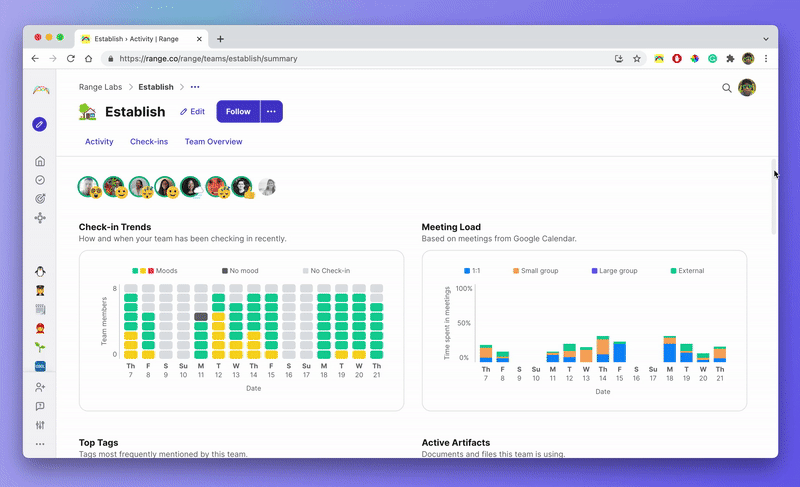With our second Lead Time Live on October 20th, 2021, Jean Hsu, VP of Engineering at Range, leads Ellen Wong, Miriam DeAna, Jen Dennard, and Nassim Kammah in a panel discussion on running remote teams.
They discuss new ideas for running your remote team, including:
- What asynchronous and synchronous touch points to set up — so you can always know what's going on.
- How to know how people are doing, without constantly being in meetings.
- What important information leaders look for to determine team health and alignment.
Check out the recording above, or an abbreviated transcript and takeaways below.
High-level approaches
With remote teams, you don’t get some of that ambient context of what’s going on that you would get for free in-person.
On remote teams, what’s your approach to knowing what’s going on work-wise and people-wise, without micromanaging?
Nassim: In my experience, it's been a lot of work in setting expectations upfront with everyone and the rules of engagement. So we make it clear what is to be done and how does everybody feels like engaging and reaching out. And from there we go from there we establish a practice of stand-ups on and Github discussions.
Miriam: Whenever we make space and normalize regular updates, it doesn't feel like a task or like micro-managing, because we all are giving updates. So that's from management, upper leadership, anyone who's working on something, — making sure that regular updates becomes a part of the environment that's expected and then it's not, “Hey, what are you doing? What are you doing? What are you doing?” because you're getting that information on a regular basis.
Ellen: The productivity side of things hasn't been as much of an issue that I want to keep track of. I’m moreso wanting to understand, what is team health? Are people feeling safe? Are they able to ask for help when they need it? Is the team cohesive and productive and happy?
Sometimes I’ll peek into the team channel and see, what is the vibe there? Are people asking questions? Are they willing to sound dumb? Are they willing to share. That's the kind of thing that I look for. Or is the channel crickets? That's a sign of not being sure how the team's doing.
What’s important to keep an eye on?
Knowing what’s going on can be especially challenging on remote teams.
There is so much that you can keep track of - what’s most important to stay on top of to monitor team health?
Jen: Establishing a cadence of checking in, whether that's through one-on-ones or through project updates and normalizing that that's not just a reporting mechanism, it's for the whole team. One of the most important things we check in on at Range is around team health and being able to monitor that. One of the challenges we see is for scaling, because you can't have 10 one-on-ones every day if you want to do any other work. What we've tried to normalize is checking in on both work and how you're feeling asynchronously, whether that's sharing a simple mood emoji of red, yellow, green, this is how I'm feeling.
Ellen: Managing through managers, there's a lot of relying on the leaders to drive their own team and make sure the team health is good. Where I do spot-check is every other week they do a retro, so I will go into the retro doc and see if there is something that is obviously terrible that needs to be addressed right away. Another thing that I try to keep in mind is, are they seeing different problems or is the same problem coming up over and over?
Nassim: I would ask pretty regularly in my one-on-ones, on a scale of 1 to 10, how do you feel on autonomy, mastery and purpose?
Those are the three metrics that Daniel Pink talks about in his book, Drive, around what makes employees feel engaged. They would say, I feel a 6 on purpose or 5 on mastery, and that’s where I would dive in, on the lowest metric — what would it take to go from a five to a six?
What does it look like? And then take it from there. So I find that monitoring week after week on those three metrics can really help detect when issues pop up.
Team engagement on remote teams
A common challenge I hear is around team engagement. What’s worked for you in keeping people engaged?
Ellen: It’s so much more important to keep your projects not running super long — make sure you have quick wins along the way. If you have a really long project, make sure you have demoable milestones along the way where people can share an asynchronous video demo and send it out and people can know, Oh, that's what you're working on. That's so awesome.
Jean: We had another panel a few months ago and Harper Reed was saying how at the end of team meetings, they'll have something they call a GIF-off where someone will choose a topic and they'll do this like apples-to-apples type thing, so someone might say “Cereal” and everyone shared a cereal-related GIF that they think that person would choose. Um, that's related to the theme of cereal. I love it because something that you absolutely would not be able to do in person.
Miriam: We do joint note-taking, which I think is good for engagement...We’ll be in a Google doc for an incident review, and it'll start off usually with 5or 10 minutes where we're filling in, this is what happened, this was the timing, these are some of the details... it's not one person taking notes. You can see five, six different people adding in what's being said, and what's being discussed after that silent period.
Supporting coworkers whose first language is not English
Q&A: “Just curious, but has anybody had the experience of having to manage folks overseas whose first language isn’t English?”
Miriam: I was formerly an English as Second Language instructor...one of the things that I love about my job right now is mentoring folks in a vocational English setting where we're talking about technology. I think the most important thing for me is having them and the whole team understand that communication and even listening is about how you convey a message. If your grammar is incorrect, or if your pronunciation is incorrect, I don't care. I just want to understand what you're saying. For example, there might be a situation where a person has a pronunciation that's wrong, but after the first time, I understand what they're saying.
Nassim: I'm personally French, as you may hear from my accent. I have like two or three other folks on my team who are French, somehow, even though we are globally distributed. I lived in the U.S. and in American culture for 16 years.
I do a lot of coaching. Communicating in an American way is very different from the French way. It's two different angles. One resource that really helped was this book called The Culture Map, and we had a book club with the other leaders within infrastructure. It really explains the spectrum of different countries, how people communicate, react, provide feedback and so on. Raising awareness of the differences was really helpful.
Supporting remote coworkers in a hybrid setting
Q&A: “I’m finding as we shift back to normal, hybrid is a lot harder than fully remote. Any tips on working in a hybrid context, and how to decrease the disadvantage of being the remote folks when say half the company is back in person.”
Jen: One of the things we talk a lot about with hybrid work is defaulting to digital, so essentially acting like everyone is still remote.
What that means is you're still doing note-taking, you're still doing facilitation rotation, you’re doing all of these best practices as if everyone were remote, because that empowers people to be in the office on different days. Even folks who are there may not be there at the same time, so you really just want to establish this foundation of communication and transparency, but also access to information.
Ellen: The reality is, if the remote population of the company is the minority, it is going to be harder, and it absolutely needs to start from the top. So one of the things that was really important to me to continue to be successful in a hybrid situation is that as a leader, you do have to — even if you are close to the office — work partially remote, because until you do, you don't quite know the pain points that your remote workers are facing.
Unique remote team practices
What’s one unique habit that your team has during a “cycle” - a meeting, ritual, or something else?
Ellen: It's hard to say what works for one team is going to work for another. So to me, what's more important is to have a system so that when problems happen, it gets resolved quickly. That iterative approach is really going to either keep the team health steady or improve it if it's not at a desired level.
In my organization, how we do that is we have retros, and we keep the team accountable for taking action on retro items that surface. That’s really helped us.
Jen: We obviously use Range pretty religiously at Range, so we do daily check-ins and those check-ins are kind of just about your work and what you're planning to do, what happened, and also how you're feeling.
What's powerful is there is an asynchronous foundation that we have about what's happening on the team, which then basically makes all of our other meetings better.
Nassim: We use GitHub discussions. It's one of the features on GitHub and we have a new topic every week. Every day we have a new comment and everyone on the team goes and they add to the comment with what they worked on, what they’re blocked on. Typical stand-up stuff, but heavy on context, a lot of context. What we found is when you come back from PTO and you just have one discussion to catch up on not to discussion, it's awesome. We no longer need to track down 10,000 GitHub issues. Everything is there. That's been extremely powerful so far.
Miriam: One of the teams at Pathstream has recently implemented a part of their like Monday goal-setting meeting where they actually talk about not task-related or team-deadline-related goals, but more personal development goals. So it might be that I would like to chop up my PRs into smaller PRs and get three PRs out the door within a given time. It's still a little technical, but not really about the code or the feature that they're writing, It’s something around their own personal development.
Jean: We have a weekly social time where we just play games together. We've discovered so many fun games — Draw Battle, Garticphone, yesterday, we played this new one that we found called Virtual Vacation.
Hopes and dreams for the future of remote work
Nassim: I'm confident that we're going to keep discovering the value of asynchronous work, the value of mind management instead of time management and not tracking people from where they are, but really empowering them and trusting that they're going to go and do what's right, because they are motivated for the right reasons.
Jen: I'm optimistic about learning how to connect remotely better. It's always funny to me when people say, I couldn't possibly feel connected without seeing people in person.
And I'm like, “do you chat with friends? Do you see all of your friends every day?” They're like “some of them I haven't seen in two years, but I feel remarkably close to.”
So I'm excited for this next horizon of async and distributed team-building and connection-building and what that looks like
Ellen: My prediction is that there will be a lot more tools like Range to make working remotely, more joyful…My hope is as we continue to progress in this remote world, that we take the best of both worlds, you know, both have more focus on your personal life, and also at the same time, have ways to continue to connect with your coworkers and be productive and happy.
Jean: Doing remote well can be difficult, but in fact, it's actually addressing some of the issues that have been in in-person workspaces that we just don't really talk about because they aren't felt as deeply or because it's kind of good enough.
You kind of get enough information, even if some people are excluded, like being the only remote worker on a hybrid team, or if there's in-groups in an office and you're not in that in-group, or people are going out for lunch without you or having coffee without you, or there are office cliques.
So I think doing remote really well can help address some of these issues and create cultures that are more inclusive, more connected, more intentional.
Miriam: We're leaving the information age and we're going into the experiential age. Having more remote teams or remote-friendly teams, I think there's going to be hybrids. There will be some people who are still going to want to go into the office, and some people are going to be in the office some. As we enter into this experiential age, I feel that having that flexibility in those choices is going to allow us to experience life at a higher level.

Range Sneak Peek
In the panel, Range's co-founder Jen shares a sneak peek of a new time-saving dashboard that's especially useful for managers of remote teams. It summarizes how people are feeling, how they're spending their time, and how work is progressing. Check out the demo here, and stay tuned for launch news!

Upcoming Event
We'll be running regular Lead Time Live events, and hope you can join us for the next one on Building Resilient Teams on November 10th.








